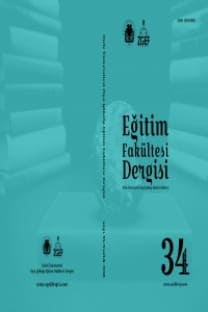SERUM NMR T1 DURULMASI İÇİN ÖNERİLEN TABAKA MODELİNDEN KİMYASAL DEĞİŞ-OLUŞ FORMÜLLERİNİN TÜRETİMİ
1H NMR, tabaka modeli, rölaksasyon zamanları, serum, kimyasal değiş-tokuş
The Derivation of Chemical Exchange Formulas for Serum NMR T1 Relaxation by Using Layer Model
1H NMR, layer model, relaxation times, serum, chemical exchange,
___
- Bertini, I, Fragai, M., Luchinat, C. & Parigi, G. (2000). H NMRD profiles of diamagnetic proteins: a model-free analysis. Magn. Reson. Chem., 38,543-550.
- Bertini, I., Gupta, Y. K. Luchinat, C. Schlörb, C. & Schwalbe, H. (2005). NMR Spectroscopic detection of protein protons and longitudinal relaxation rates between 0.01 and 50 MHz, Angew. Chem, 117, 2263-2265.
- Blicharska, B. & Rydzy, M. (1979). Investigation of protein denaturation by nuclear magnetic relaxation method, Acta Physica Polonica, A56, 439-443.
- Cameron, I. L, Ord, V. A. & Fullerton, G. D. (1988). Water of hydration in the intra and extra cellular environment of human erythrocytes. Biochem.Cell.Biol., 66,1186-1199.
- Daskiewicz, O. K., Hennel, J. W. & Lubas, B. (1963). Proton magnetic relaxation and protein hydration, Nature, 200,1006-1007.
- Eley, D. D., Hey, M. J. & Ward , A. J. I. (1974). Nuclear Magnetic Resonance Relaxation in Aqueous Bovine Albümin Solutions, J.Chem.Soc.Faraday Transact.I, 5,1106-1113.
- Fullerton, G. D., Ord, V. A. & Cameron,I.L. (1986). An evaluation of the hydration of
- lysozyme by a NMR titration method. Biochim.Biophys.Acta, 869,230-246.
- Fullerton, G.D., Finnie, M. F., Hunter, K. E., Ord, A. & Cameron, I. L. (1987). The ınfluence of macromolecular polymerization on spin-lattice relaxation of aqueous solutions, J.Magn.Reson.Imaging, 5,353-370.
- Gallier, J., Rivet, P. & Certaınes, J.de. (1987). 1H- and 2H-NMR study of bovine serum albumin solutions. Biochimica et Biophysica Acta, 915,1-18.
- Grösch, L. & Noack, F. (1976). NMR relaxation investigation of water mobility in aquueous bovine serum albumin solutions. Biochimica et Biophysica Acta, 453,218-232.
- Halle, B. (2004). Protein hydration dynamics in solution: a critical survey, Phil. Trans. R. Soc. Lond. B., 359,1207-1224.
- Kavak, G. (2000). “Serum Proteinlerinin Spin-Örgü Durulma Mekanizmalarının NMR ile incelenmesi”. Yayımlanmış doktora tezi, Dicle Üniversitesi Fen Bilimleri Enstitüsü, Diyarbakır.
- Pouliquen, D. & Gallois, Y. (2001). Physicochemical properties of structured water in human albumin and gammaglobulin solutions. Biochimie., 83,891-898.
- Yılmaz, A., Ulak F. Ş. & Batun, M.S. 2004. Proton T1 and T2 relaxivities of serum proteins, Magnetic Resonance İmaging, 22(7) 683-688.
- ISSN: 1305-0060
- Yayın Aralığı: Yılda 2 Sayı
- Başlangıç: 1995
- Yayıncı: Dicle Üniversitesi
DEDE KORKUT HİKÂYELERİNDE SÖZ KALIPLARI
EKONOMİK GELİŞME SÜRECİNDE TARIM-SANAYİ İLİŞKİLERİNİN SEKTÖRLER ARASI BÜTÜNLEŞMEYE ETKİLERİ
FEN EĞİTİMİNDE PROBLEM ÇÖZME İLE İLGİLİ AÇIKLAMALI KAYNAKÇA
HÜCRE BÖLÜNMELERİNİN ÖĞRETİMİNDE YENİ BİR YAKLAŞIM: “BÖLÜNEN PARMAKLAR”
BİLİŞSEL ÖĞRENMELER İÇİN ELEŞTİREL OKUMANIN ÖNEMİ ve ONU GELİŞTİRME YOLLARI
HİPERBOLİK TANJANT YÖNTEMİNİN KLASİK BOUSSINESQ SİSTEMİNE UYGULANMASI
